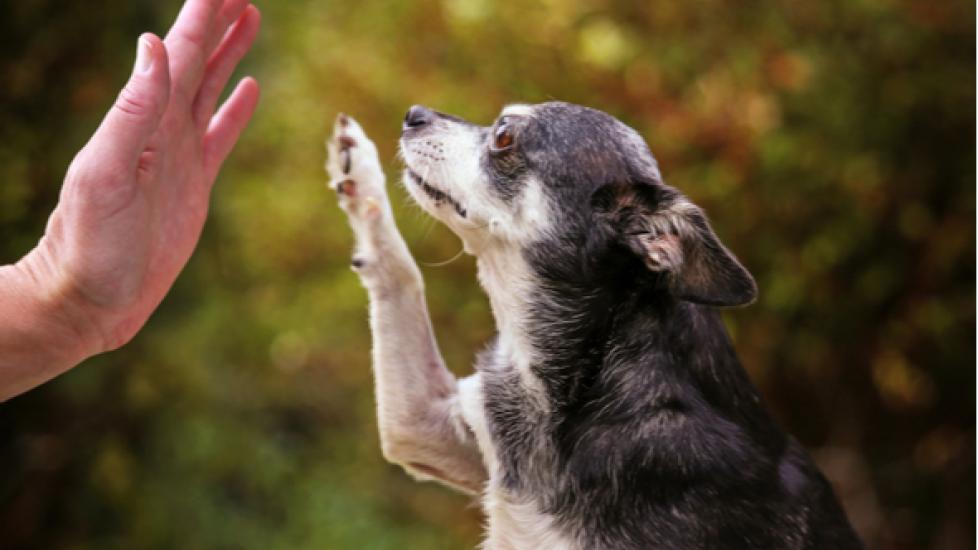Can You Teach an Old Dog New Tricks?
Image via Annette Shaff/Shutterstock.com
By LisaBeth Weber
The phrase “you can’t teach an old dog new tricks” is often not about a dog. But in the literal sense, asking whether old habits can be replaced with new behavior is a good question.
Molly Sumner Sumridge, certified dog behavior consultant and owner of Kindred Companions in Frenchtown, New Jersey, feels that age has nothing to do with learning ability, though she does cite learning history as a potential challenge. “A puppy is a clean slate, so habits haven’t been formulated yet. Being consistent and keeping things simple is key to training dogs of any age.”
For senior dogs, unless they’re exhibiting signs of significant cognitive dysfunction, training shouldn’t be any different than with a younger adult dog, though they may have less stamina for repetition. Sumridge had a senior dog that was half blind, deaf and struggling with cognition problems, but still wanted to keep learning. Sumridge is convinced that training is what kept her going till age 16.
Training Tips for Older Dogs
Start With Easy Dog Tricks
Learning helps to keep a dog’s brain in shape. Start with easy dog tricks as you would with puppies, but once they’re succeeding, don’t be afraid to try more complicated dog tricks.
Recommended Products
Be Clear and Go Slow
When a dog is confused or failing, it’s usually because of something the human is or isn’t doing, like not being clear, rushing or combining too many learning behaviors together. One of the biggest challenges in training adult dogs is clear criteria and generous reinforcement.
“Owners who worry about getting training done fast and without treats will be sorely disappointed,” Sumridge says. “Regardless of age, when we slow down and reward each tiny step, we get happy dogs, eager to cooperate.” Patience is very important, but with senior dogs, extra patience and compassion are essential when teaching dog tricks, particularly if they struggle with cognitive and physical decline.
Try Interactive Dog Toys
Dr. Shannon Stanek, DVM, owner and head veterinarian of Exton Vet Clinic in Pennsylvania, says that most dogs thrive on interaction and using their brains, no matter their age.
Dog interactive toys like the OurPets Buster Food Cube dog toy and Busy Buddy Kibble Nibble dog toy are great “training assistants.” Sumridge highly recommends dog treat toys and dispenser as a way to keep dogs of all ages busy and seniors feeling young.
They also provide an outlet for natural foraging behaviors and act as positive brain stimuli, burning energy and sending happy hormones to the brain. “It’s called contrafreeloading,” Sumridge explains. “Dogs get happiness and satisfaction from working to obtain food. For senior dogs, it makes them use their brain, which helps stave off cognitive degeneration.”
Be Consistent and Positive
Focusing on consistency is key to successful training. Dr. Stanek emphasizes positive, confidence-building exercises for both puppies and adult dogs. “The biggest difference is that grown-up dogs usually have to unlearn bad habits,” she says. “They may also be fearful of new things. Elder dogs are usually calmer and willing but may have cognitive issues, whereas puppies are willing and looking for guidance.” Dogs learn well through repetition.
Assess Your Senior Pet’s Health
“The biggest issues I see with older dogs are that their cognitive and physical decline is written off as the dog just getting older. Age is not a disease,” says Dr. Stanek. If a dog is having difficulty with training, then it is best to have a veterinarian evaluate for health issues that may be a contributing factor. This can happen more frequently with elder dogs.
If a physical illness is addressed, it can sometimes solve training issues. This is especially common with house soiling and destructive behaviors. Other than physical limitations due to age, Dr. Stanek doesn’t see a need to limit the amount of training done with a senior dog.
Build Rapport
In cases where you don’t know the dog’s history, such as with strays or rescue dogs, it’s good to start out by building rapport. Reward the dog for simple behaviors like relaxing, sitting on their own or coming over to you.
Trust takes time, especially if they have been through trauma. Dog food and dog treats offer a great way to strengthen the bond and help the dog interact with you.
Once trust is attained, you can move on to fundamental behavior training. Training can keep senior dogs active, healthy and happy.
Don’t Give Up
Sumridge says, “Never give up on training your dog based on age. Learning is a lifetime endeavor; it keeps your dog young and your bond strong.”




